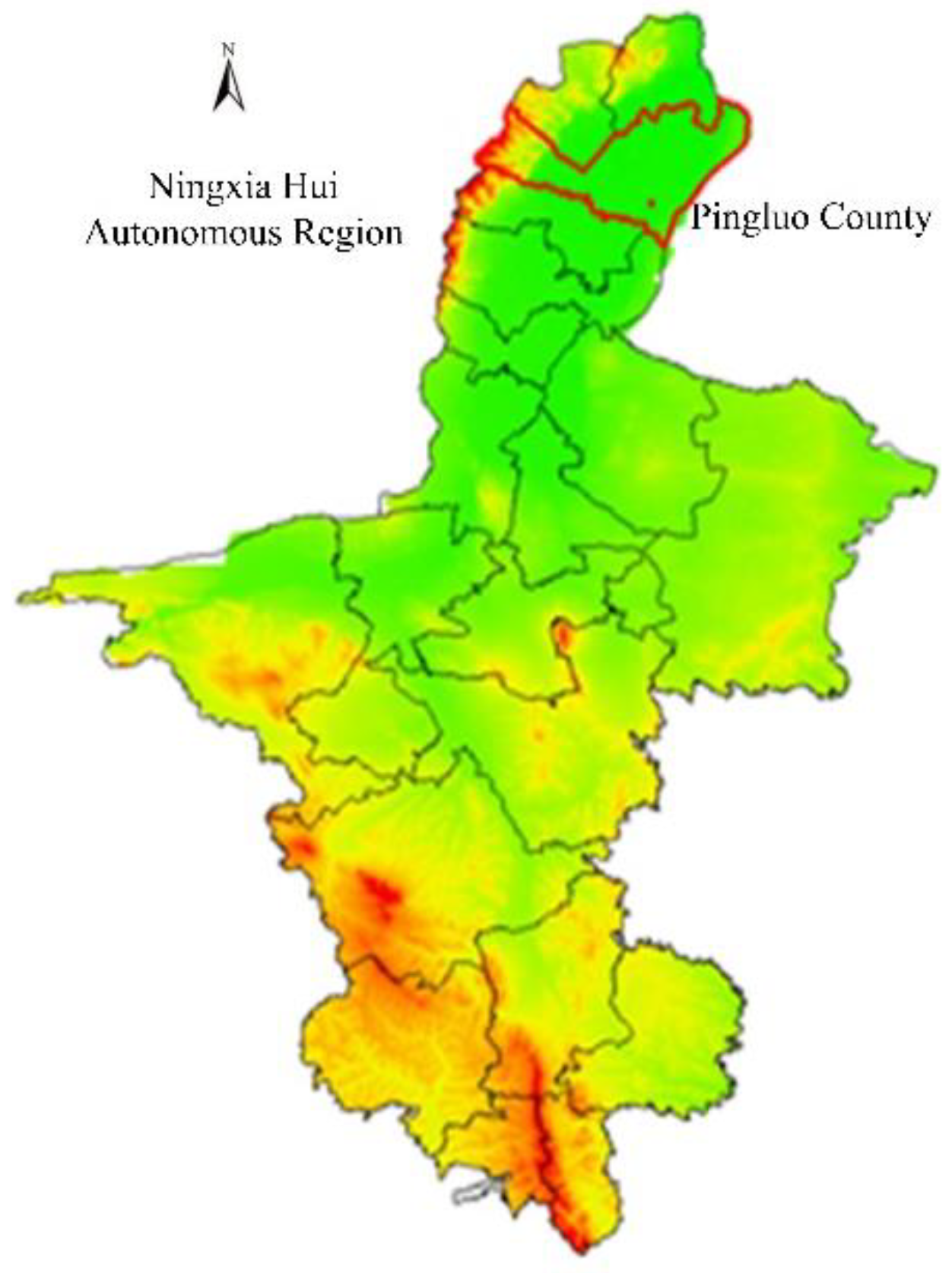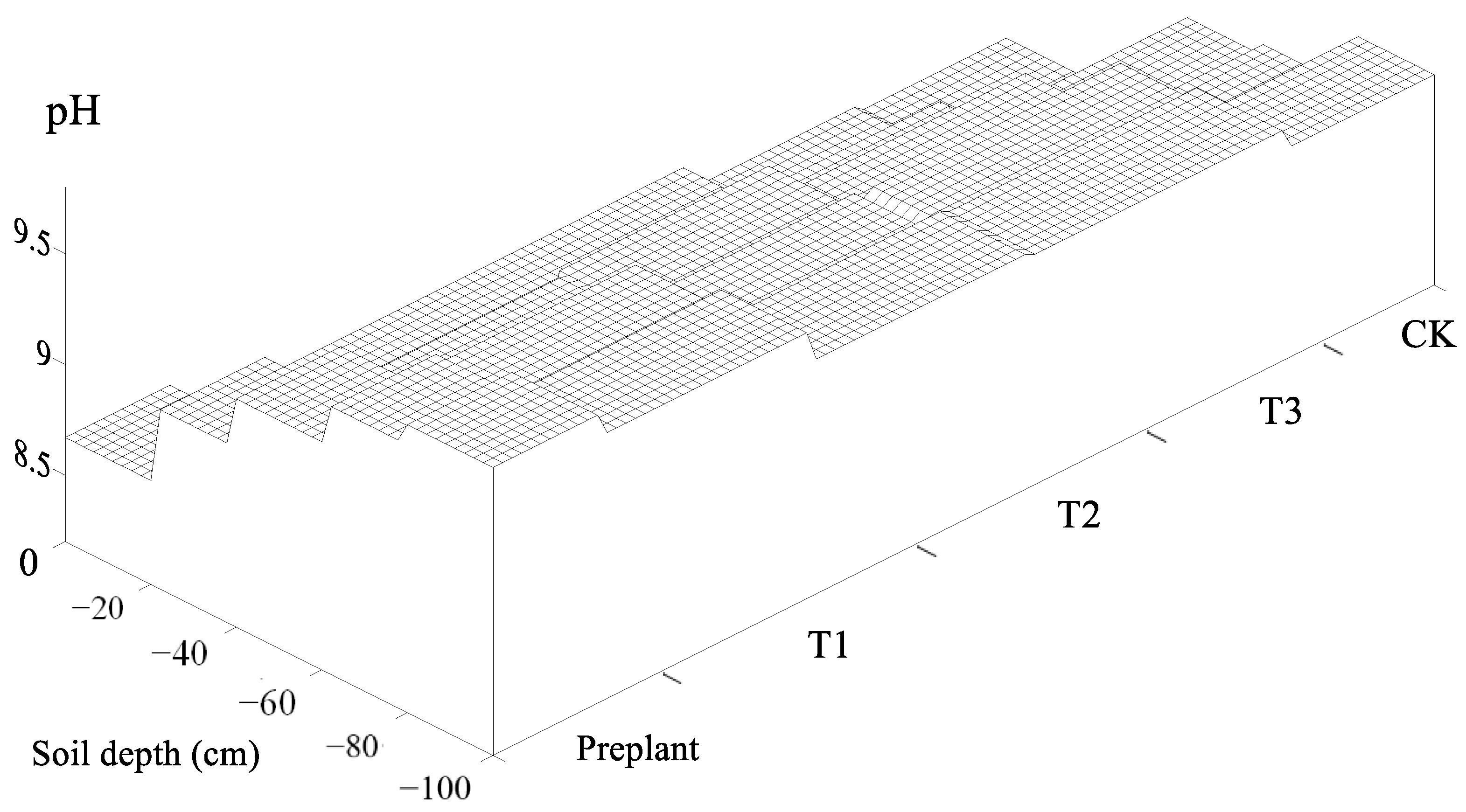Effects of Ditch Water and Yellow River Irrigation on Saline–Alkali Characteristics of Soil and Paddy
Abstract
:1. Introduction
2. Materials and Methods
2.1. Overview of Study Area
2.2. Experimental Design and Implementation Process
2.3. Soil Sample Collection and Determination
2.4. Data Processing and Analysis
3. Results
3.1. Water Quality Variations of Gully Water and Yellow River Water
3.2. Effects of Different Treatments on Soil Saline–Alkali Properties
3.3. Effects of Different Treatments on Soil Heavy Metals
3.4. Effects of Different Treatments on Heavy Metals and Paddy Yield
4. Discussion
5. Conclusions
- (1)
- Ditch water salinity from the experimental field was less than 1.60 g/L and its pH value was lower than 8.62 during the rice growth period from May to August in Pingluo County, Ningxia; the water is therefore classified as mildly brackish water suitable for farmland irrigation.
- (2)
- The application of ditch water irrigation for rice did not lead to soil salinity and alkali aggravation, and the heavy metal concentrations in both soil and rice remained within specified standard values. The heavy metal concentration in soil complied with the requirements of the Secondary Standard of Soil Environmental Quality, while the heavy metal concentration in rice met the requirements of the National Standard of Food Safety.
- (3)
- The rice yields for the CK, T1, T2, and T3 treatments were 10,437.5, 8318.4, 9182.1, and 9016.2 kg/hm2, respectively. Compared with Yellow River irrigation, the rice yields for T1, T2, and T3 treatments were 20.3%, 12.1%, and 13.6% lower than that for CK, respectively, with minimal differences among them.
Author Contributions
Funding
Data Availability Statement
Conflicts of Interest
References
- Wang, X.; Xiao, X.; Zou, Z.; Dong, J.; Qin, Y.; Doughty, R.; Menarguez, M.; Chen, B.; Wang, J.; Ye, H.; et al. Gainers and losers of surface and terrestrial water resources in China during 1989–2016. Nat. Commun. 2020, 11, 3471. [Google Scholar] [CrossRef] [PubMed]
- Gu, X.; Zhang, F.; Wang, T.; Xie, X.; Jia, X.; Xu, X. Effects of Nitrogen and Phosphorus Addition on Growth and Leaf Nitrogen Metabolism of Alfalfa in Alkaline Soil in Yinchuan Plain of Hetao Basin. PeerJ 2022, 10, e13261. [Google Scholar]
- Zhu, X.; Liu, J.; Qi, W.; Gao, X.; Zhao, X.; Zhu, B. Future changes and distribution of water resources in China under global warming levels of 1.5–4.5 °C. J. Hydrol. 2024, 53, 101781. [Google Scholar] [CrossRef]
- Lu, C.; Xi, R.; Hei, Z.; Tang, L. Safety Evaluation of Water Environment Carrying Capacity of Five Cities in Ningxia Based on Ecological Footprint of Water Resources. Asian Agric. Res. 2022, 14, 11–16. [Google Scholar]
- Hazem, T.; Guan, H. Hyperspectral remote sensing for extraction of soil salinization in the northern region of Ningxia. Model. Earth Syst. Environ. 2020, 6, 2487–2493. [Google Scholar]
- Kamel, N.; Mohamed, M.; Netig, B. Impacts of Irrigation Regimes with Saline Water on Carrot Productivity and Soil Salinity. J. Saudi Soc. Agric. Sci. 2012, 11, 19–27. [Google Scholar]
- Zhao, J.; Zhang, X.; Yang, Y.; Zang, H.; Yan, P.; Meki, M.; Doro, L.; Sui, P.; Jeong, J.; Zeng, Z. Alternative cropping systems for groundwater irrigation sustainability in the North China Plain. Agric. Water Manag. 2021, 250, 106867. [Google Scholar] [CrossRef]
- Fan, L.; Li, L.; Wu, X.; Wang, X. Effects of Leaching with Different Quality Water and Soil Amendments Application on Soil Water and Salt Transport in Alkalize Solonchaks in Yinbei Irrigation District. J. Soil Water Conserv. 2020, 34, 369–376. (In Chinese) [Google Scholar]
- Zhang, P.; Shen, J. Effect of brackish water irrigation on the movement of water and salt in salinized soil. Open Geosci. 2022, 14, 404–413. [Google Scholar] [CrossRef]
- Lyu, S.; Wu, L.; Wen, X.; Wang, J.; Chen, W. Effects of reclaimed wastewater irrigation on soil-crop systems in China: A review. Sci. Total Environ. 2022, 813, 152531. [Google Scholar] [CrossRef]
- Gao, H.; Fu, T.; Tang, S.; Liu, J. Effects of saline water irrigation on winter wheat and its safe utilization under a subsurface drainage system in coastal saline-alkali land of Hebei Province, China. Irrig. Sci. 2023, 41, 251–260. [Google Scholar] [CrossRef]
- Wei, C.; Li, F.; Yang, P.; Ren, S.; Wang, S.; Wang, Y.; Xu, Z.; Xu, Y.; Wei, R.; Zhang, Y. Effects of Irrigation Water Salinity on Soil Properties, N2O Emission and Yield of Spring Maize Under Mulched Drip Irrigation. Water 2019, 11, 1548. [Google Scholar] [CrossRef]
- GB 2762-2017; National Standard for Food Safety. China Food and Drug Administration. Standards Press of China: Beijing, China, 2017; pp. 2–9. (In Chinese)
- Wang, Z.; Tian, J. Effects of Fertilizer Application Quotas on Rice Yield, Quality and Heavy Metal Content under Reclaimed Water Irrigation. Ningxia Eng. Technol. 2022, 21, 326–330. (In Chinese) [Google Scholar]
- Wang, L.; Zhou, L.; Hu, J.; Cai, J.; Wang, W.; Xiao, W.; He, M. Effects of reclaimed water irrigation on the distribution of heavy metal in paddy fields. J. Drain. Irrig. Mach. Eng. 2022, 40, 842–849. (In Chinese) [Google Scholar]
- Wang, X.; Shen, J.; Fan, L.; Zhang, Y. Research on Salt Drainage Efficiency and Anti-Siltation Effect of Subsurface Drainage Pipes with Different Filter Materials. Water 2024, 16, 1432. [Google Scholar] [CrossRef]
- GB 5084-2021; Water Quality Standard for Farmland Irrigation. Ministry of Ecology and Environment. Standards Press of China: Beijing, China, 2021; pp. 3–4. (In Chinese)
- GB 3838-2002; Surface Water Environmental Quality Standard. State Environmental Protection Administration. Standards Press of China: Beijing, China, 2002; pp. 2–4. (In Chinese)
- GB 15618-1995; Standard for Soil Environmental Quality. Ministry of Ecology and Environment. Standards Press of China: Beijing, China; pp. 2–4. (In Chinese)
- Liu, C.; Cui, B.; Hu, C.; Wu, H.; Gao, F. Effects of mixed irrigation using brackish water with different salinities and reclaimed water on a soil-crop system. Water Reuse 2021, 11, 632–648. [Google Scholar]
- Wang, Y.; Xiao, Y.; Puig-Bargués, J.; Zhou, B.; Liu, Z.; Muhammad, T.; Liang, H.; Maitusong, M.; Wang, Z.; Li, Y. Assessment of water quality ions in brackish water on drip irrigation system performance applied in saline areas. Agric. Water Manag. 2023, 289, 108544. [Google Scholar] [CrossRef]
- Bao, S. Agrochemical Analysis of Soil; China Agriculture Press: Beijing, China, 2018; pp. 178–179. (In Chinese) [Google Scholar]
- Zhao, H.; Li, L.; Fan, G.; Xie, S.; Li, F. Effects of aerated brackish water irrigation on growth of Lycium barbarum seedlings. Sci. Hortic. 2023, 310, 111721. [Google Scholar] [CrossRef]
- Li, X.; Kang, Y. Water-salt control and response of Chinese rose (Rosa chinensis) root on coastal saline soil using drip irrigation with brackish water. Trans. Chin. Soc. Agric. Eng. 2019, 35, 112–121. (In Chinese) [Google Scholar]
- Kazuto, S.; Tomoka, K.; Takafumi, T.; Riku, T.; Fumiaki, N.; Tamihisa, O.; Masaki, N.; Yuji, Y.; Hideki, K. Effects of paddy irrigation-drainage system on water quality and productivity of small rivers in the Himi region of Toyama, Central Japan. J. Environ. Manag. 2023, 342, 118305. [Google Scholar]
- Li, S.; Liu, H.; Zhang, L.; Li, X.; Wang, H.; Zhuang, Y.; Zhang, F.; Zhai, L.; Fan, X.; Hu, W.; et al. Potential nutrient removal function of naturally existed ditches and ponds in paddy regions: Prospect of enhancing water quality by irrigation and drainage management. Sci. Total Environ. 2020, 718, 137418. [Google Scholar] [CrossRef] [PubMed]
- Eldardiry, E.; El-Hady, M.; Zaghloul, A. Relationship Between Soil Physical and Chemical Properties and Hydrophysical Soil Properties Under Reuse of Agricultural Drainage Water. Am.-Eurasian J. Agric. Environ. Sci. 2013, 13, 1–6. [Google Scholar]
- Wang, Y. Return Flow Water Quality and Reuse in Saline-alkali Paddy Soils; University of Chinese Academy of Sciences: Changchun, China, 2015; p. 104. (In Chinese) [Google Scholar]




| Item | Component Content | Five-Day Biochemical Oxygen Demand (BOD) | Chemical Oxygen Demand (COD) | Anion Surface Active Dose | ||||||||||
|---|---|---|---|---|---|---|---|---|---|---|---|---|---|---|
| Total Nitrogen | Total Phosphorus | Suspended Matter | Zn | Ni | Se | As | Hg | Cd | Pb | Cr | ||||
| Ditch water | 1.8 | 0.042 | 2.5 | 0.01 | 0.001 | None | 0.001 | None | None | 0.001 | 0.004 | 4.5 | 7.5 | None |
| Threshold value | ≤2.0 (Class V) | ≤0.2 (Class I) | ≤80 | ≤2 | ≤0.2 | ≤0.02 | ≤0.05 | ≤0.001 | ≤0.01 | ≤0.2 | ≤0.1 | ≤60 | ≤150 | ≤5 |
| Item | As | Hg | Cd | Cr | Pb |
|---|---|---|---|---|---|
| Before planting | 15.53 ± 1.43 ab | 0.04 ± 0.01 b | 0.13 ± 0.01 a | 32.01 ± 3.26 b | 15.33 ± 0.82 b |
| T1 | 16.87 ± 1.65 a | 0.13 ± 0.02 a | 0.17 ± 0.01 a | 39.74 ± 4.06 a | 20.16 ± 1.42 a |
| T2 | 16.32 ± 0.96 a | 0.09 ± 0.01 ab | 0.15 ± 0.01 a | 36.23 ± 3.12 ab | 18.39 ± 1.06 ab |
| T3 | 16.57 ± 1.32 a | 0.11 ± 0.02 a | 0.14 ± 0.01 a | 37.76 ± 2.86 ab | 19.75 ± 0.97 ab |
| CK | 15.12 ± 1.13 b | 0.05 ± 0.01 b | 0.12 ± 0.01 a | 32.57 ± 1.68 b | 16.17 ± 1.32 b |
| GB15618—1995 | 25.0 | 1.0 | 0.6 | 250.0 | 350.0 |
| Item | Heavy Metal Content (mg/kg) | Yield (kg/hm2) | ||||
|---|---|---|---|---|---|---|
| As | Hg | Cd | Pb | Cr | ||
| T1 | 0.23 ± 0.09 a | 0.006 ± 0.002 a | 0.08 ± 0.02 a | 0.26 ± 0.07 a | 0.37 ± 0.09 a | 8318.4 ± 134.7 c |
| T2 | 0.15 ± 0.03 a | 0.004 ± 0.001 a | 0.06 ± 0.01 a | 0.21 ± 0.09 a | 0.24 ± 0.06 ab | 9182.1 ± 128.9 b |
| T3 | 0.16 ± 0.04 a | 0.005 ± 0.001 a | 0.07 ± 0.01 a | 0.17 ± 0.04 a | 0.21 ± 0.08 ab | 9016.2 ± 157.3 b |
| CK | 0.08 ± 0.02 b | 0.003 ± 0.001 a | 0.04 ± 0.01 a | 0.11 ± 0.03 a | 0.17 ± 0.07 b | 10,437.5 ± 187.5 a |
| GB2762—2017 | 0.5 | 0.02 | 0.2 | 0.5 | 1 | |
Disclaimer/Publisher’s Note: The statements, opinions and data contained in all publications are solely those of the individual author(s) and contributor(s) and not of MDPI and/or the editor(s). MDPI and/or the editor(s) disclaim responsibility for any injury to people or property resulting from any ideas, methods, instructions or products referred to in the content. |
© 2024 by the authors. Licensee MDPI, Basel, Switzerland. This article is an open access article distributed under the terms and conditions of the Creative Commons Attribution (CC BY) license (https://creativecommons.org/licenses/by/4.0/).
Share and Cite
Fan, L.; Shen, J.; Wang, X.; Zhang, Y. Effects of Ditch Water and Yellow River Irrigation on Saline–Alkali Characteristics of Soil and Paddy. Water 2024, 16, 2598. https://doi.org/10.3390/w16182598
Fan L, Shen J, Wang X, Zhang Y. Effects of Ditch Water and Yellow River Irrigation on Saline–Alkali Characteristics of Soil and Paddy. Water. 2024; 16(18):2598. https://doi.org/10.3390/w16182598
Chicago/Turabian StyleFan, Liqin, Jingli Shen, Xu Wang, and Yonghong Zhang. 2024. "Effects of Ditch Water and Yellow River Irrigation on Saline–Alkali Characteristics of Soil and Paddy" Water 16, no. 18: 2598. https://doi.org/10.3390/w16182598





